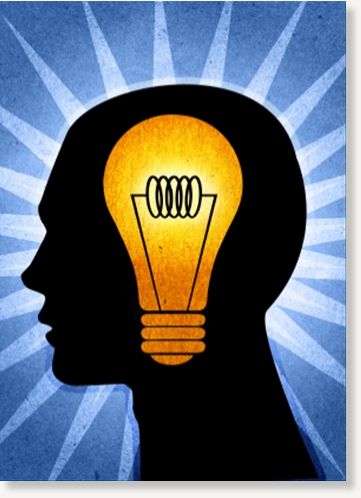We put these individuals in a special category called "genius." We assume these individuals — like Leonardo da Vinci, Albert Einstein, Mozart and Marie Curie — had what we don't, and thereby are the only ones who can be creative, the only ones who can create.
We assume creation is a magical, mystical process that regular people just aren't privy to. We assume creation happens spontaneously through aha! moments and epiphanies that strike like lightning. We assume creativity is like a stroll along a quiet street or a steady stream: smooth, effortless, graceful, forward moving.
We assume creation looks just like Mozart's own process, which he described in 1815 in a letter to Germany's General Music Journal:
When I am, as it were, completely myself, entirely alone, and of good cheer; say traveling in a carriage, or walking after a good meal, or during the night when I cannot sleep; it is on such occasions that my ideas flow best and most abundantly. All this fires my soul, and provide I am not disturbed, my subject enlarges itself, becomes methodized and defined, and the whole, though it be long, stands almost finished and complete in my mind, so that I can survey it, like a fine picture or a beautiful state, at a glance...Kevin Ashton features Mozart's letter in his new book How to Fly a Horse: The Secret History of Creation, Invention and Discovery. The letter reveals that Mozart's symphonies came to him as whole creations. All he had to do was transcribe the compositions from his imagination.
Or does it?
Decades after Mozart's letter was published in the German journal, his biographer showed that it was actually a fake (which others have confirmed).
According to Ashton, not only is the letter bogus but it also perpetuates a slew of myths about the creative process. It "implies that few people can be creative, that any successful creator will experience dramatic flashes of insight, that creating is more like magic than work. A rare few have what it takes, and for them it comes easy. Anybody else's creative efforts are doomed."
Ashton himself is an inventor. He led pioneering work on radio frequency identification (RFID) networks, and co-founded the Auto-ID Center at MIT. In How to Fly a Horse, he shatters this "creativity myth."
He shows us what the creative process really looks like. And it looks like a whole lot of effort and unwavering persistence, a series of small steps, and a litany of mistakes and failures.
In Mozart's real letters to his family, he revealed that he revised his compositions, sometimes got stuck, needed a piano and harpsichord to compose, left and returned to his work, and contemplated theory, craft, melody and rhythm when composing.
Ashton's book is filled with stories of inventors who worked tirelessly to produce their creations and failed often. As he writes, "creation is not a moment of inspiration but a lifetime of endurance."
For instance, inventor James Dyson, known for his Dyson vacuum, created 5,000 prototypes over five years to perfect the cyclone-based technology. Ashton includes this quote from Dyson, "I'm a huge failure because I made 5,126 mistakes."
Even art, which looks spontaneous, soulful and dreamlike, requires many steps and revisions and months and years of sweat. Ashton tells the story of Wassily Kandinsky's creation, "Painting with White Border."
According to Ashton, "Kandinsky spent five months planning every stroke of his apparently spontaneous painting and years developing the method and theory that took him to it." He encountered different problems, which he solved one at a time. In one of his many sketches Kandinsky created 20 different versions of the troika, a sled with three horses, which he and other Russians used "to represent their nation's divinity."
Creativity is small steps, not giant leaps, or flashes of "genius." Again, it's steady work. Ashton tells the story of the Wright brothers, who built the first successful airplane. Ashton writes:
For the Wright brothers — like others — there also were hiccups and steps back. For instance, it took them two years to make a kite that was big enough to carry a pilot. That's when they learned that the existing scientific data they were using was all wrong. So they made their own calculations.Their glider of 1900 looked like their kite of 1899. Their glider of 1901 looked like their glider of 1900 but with a few new elements. Their glider of 1902 was their glider of 1901, bigger and with a rudder. Their 1903 Flyer — the aircraft that flew from Kitty Hawk's sands — was their 1902 glider made bigger again with propellers and an engine added. Orville and Wilbur Wright did not leap into the sky. They walked there one step at a time.
Each of us is born to create. As Ashton writes, "There is no electric fence between those who can create and those who cannot, with genius on one side and the general population on the other."
Creativity is innate. This is why it might seem magical, he says. Some of us might be better at creating than others, just like some of us are better orators or athletes, he says. But the truth remains: "we can all create."
We just need to remember that the creative process requires many steps (often teeny-tiny) and missteps, revisions and wrong turns and the perseverance to keep going. And going.
Because, as Ashton writes in one of my favorite observations in How to Fly a Horse: "We are more like Leonardo, Mozart, and Einstein than not."




Thomas Edison is quoted as saying "Genius is 1% inspiration and 99% perspiration."
[Link]